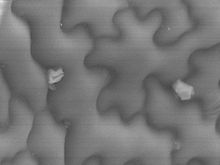Plant cell
- For the scientific journal see The Plant Cell.

Plant cells are quite different from the cells of the other eukaryotic kingdoms' organisms. Their distinctive features include:
- A large central vacuole (enclosed by a membrane, the tonoplast), which maintains the cell's turgor and controls movement of molecules between the cytosol and sap.
- A cell wall composed of cellulose and protein, and in many cases lignin, and deposited by the protoplast on the outside of the cell membrane. This contrasts with the cell walls of fungi, which are made of chitin, and prokaryotes, which are made of peptidoglycan.
- The plasmodesmata, linking pores in the cell wall that allow each plant cell to communicate with other adjacent cells. This is different from the network of hyphae used by fungi.
- Plastids, especially chloroplasts that contain chlorophyll, the pigment that gives plants their green color and allows them to perform photosynthesis.
- Plant groups without flagella (including conifers and flowering plants) also lack centrioles that are present in animal cells.
Cell types
Parenchyma cells - These cells are the biochemistry machines of the plant. They are alive at maturity and are specialized in any number of structural and biochemical ways. Other than support functions, this cell type is the basis for all plant structure and function. Parenchyma cells have thin primary walls, and highly functional cytoplasm. The cells are alive at maturity and are responsible for a wide range of biochemical function. For example, other than xylem in vascular bundles, the leaf is composed of parenchyma cells. Some, as in the epidermis, are specialized for light penetration, regulating gas exchange, or anti-herbivory physiology. Other cells, as in the mesophyll, are specialized for photosynthesis or phloem loading.
- Collenchyma cells - Collenchyma cells are also alive at maturity and have only a primary wall. These cells mature from meristem derivatives. They pass briefly through a stage resembling parenchyma, however they are determined to differentiate into collenchyma, and this fact is quite obvious from the very earliest stages. Plastids do not develop and secretory apparatus (ER and Golgi) proliferates to assist in the accumulation of additional primary wall. This is laid down where three or more cells come in contact. Areas of wall where only two cells come in contact remain as thin as those of parenchyma cells.
The design and function is to build and maintain the special unevenly thick primary cell wall. The cells are also typically quite elongate. The role of this cell type is to support the plant in areas still growing in length. The primary wall lacks lignin that would make it brittle, so this cell type provides what could be called plastic support. Support that can hold a young stem or petiole into the air, but in cells that can be stretched as the cells around them elongate. Stretchable support (without elastic snap-back) is a good way to describe what collenchyma does. Parts of the strings in celery are collenchyma.
- Sclerenchyma cells - These cells are hard and brittle (as you might expect from the root: scler-. The cells develop an extensive secondary cell wall (laid down on the inside of the primary wall). This wall is invested with lignin, making it extremely hard. Lignin, plus suberin and/or cutin make the wall waterproof as well. Thus, these cells cannot survive for long as they cannot exchange materials well enough for active (or even maintaining) metabolism. They are typically dead at functional maturity...the cytoplasm is missing by the time the cell can begin to carry out its funciton.
Functions for sclerenchyma cells include discouraging herbivory (hard cells that rip open digestive passages in small insect larval stages, hard cells forming a pit wall in a peach fruit), support (the wood in a tree trunk, fibers in large herbs), and conduction (hollow cells lined end-to-end in xylem with cytoplasm and end walls missing).
Tissue types

These three major classes of cells can then differentiate to form the tissue structures of roots, stems, and leaves. Plants have these types of tissues, and they have similar locations within all species of plants. However, the amount of these tissues will vary for different plant species.
The three distinct types of plant cells are classified according to the structure of their cell walls and features of their protoplast. Plants will have a primary cell wall and sometimes a secondary wall as well. These two major parts are what determines the function of each individual plant cell.
- Dermal tissue - The outermost covering of a plant
- Vascular tissue - Responsible for transport of materials throughout the plant
- Ground tissue - Performs photosynthesis, starch storage and structural support; ground tissues may be composed of one of three cell types
- Parenchyma - Thin primary walls, may not have a secondary wall; can develop into more specialized plant tissues
- Collenchyma - Unevenly thickened primary walls, grouped together to support growing parts of the plant
- Sclerenchyma - Thick secondary walls, used to support non-growing parts of the plant
Parts
- Cell membrane
- Cell wall
- Plasmodesma
- Vacuole
- Tonoplast
- Crystal
- Plastids
- Golgi Complex
- Ribosome
- Endoplasmic reticulum
- Mitochondrion
- Microtubule
- Microfilament
- Lysosome
- Microbody
- Hyaloplasm
- Nucleus
